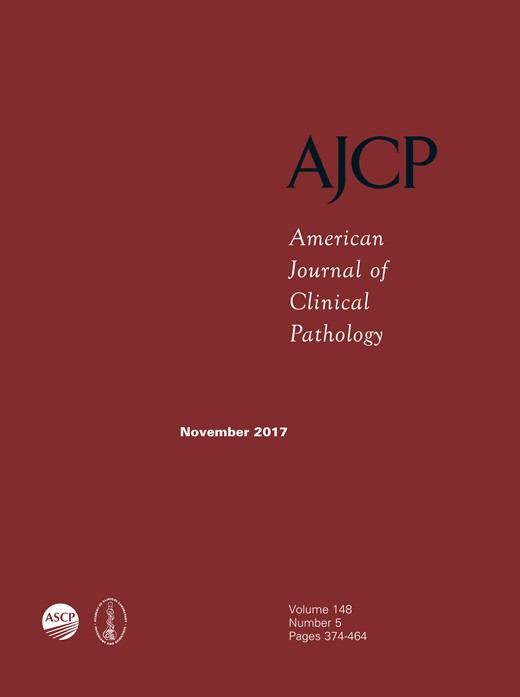-
PDF
- Split View
-
Views
-
Cite
Cite
Parul Tandon, Jeffrey D McCurdy, Thomas C Smyrk, Is Standard Histology Sufficient to Detect Cytomegalovirus Reactivation in Inflammatory Bowel Disease?, American Journal of Clinical Pathology, Volume 148, Issue 5, November 2017, Pages 459–460, https://doi.org/10.1093/ajcp/aqx045
Close - Share Icon Share
To the Editor
We read with great interest the recent article by Solomon et al,1 who assessed the diagnostic accuracy of viral cytopathic effect (VCPE) for detecting routine viral infections in surgical specimens. The authors determined the sensitivity and specificity of VCPE from H&E-stained surgical specimens compared with immunohistochemistry (IHC) as the reference standard and evaluated if changes in therapeutic decisions were required in cases of positive IHC in the absence of detectable VCPE. We were particularly interested in the results regarding the diagnostic accuracy of IHC for cytomegalovirus (CMV). From 59 positive samples by IHC, it was demonstrated that definitive VCPE had a sensitivity of 67.8%. Therefore, the authors concluded “the presence of VCPE on H&E sections is sufficient for diagnosis in most cases.” We have substantial concerns regarding the generalizability of these results in light of potential methodologic limitations and conflicting studies, particularly when considering patients with inflammatory bowel disease (IBD).
The sensitivity of H&E histology for CMV reactivation in IBD is consistently poor. We previously demonstrated that H&E histology, when assessed prospectively, has an overall sensitivity of only 25% for detecting CMV reactivation compared with IHC.2 Even in patients with high-grade CMV disease, defined as five or more inclusions by IHC, the sensitivity of H&E histology was only 44%.2 Similarly, in a systematic review and meta- analysis assessing 373 patients with IBD from nine studies, the overall sensitivity of H&E histology was 12.5% (95% confidence interval [CI], 3.6%-21.4%), 34.6% (95% CI, 13.8%-55.4%) compared with IHC as the reference standard, and 4.7% (95% CI, 1.2%-17.1%) compared with tissue polymerase chain reaction (PCR) as the reference standard.3
The low diagnostic yield of CMV in IBD may be related to a “needle in a haystack” phenomenon.4 In keeping with this concept, we previously demonstrated that the diagnostic yield is greater when samples are re-reviewed.2 In the current study, the sensitivity of VCPE for CMV was determined retrospectively by re-reviewing tissue samples instead of from the original pathology reports and was determined by three pathologists. Both of these factors are likely to have increased the overall sensitivity of VCPE and do not reflect real-world practice. It has also been proposed that the typical histologic changes associated with CMV infection, including large cells with thickened nuclear membranes, granular cytoplasmic inclusions, and basophilic intranuclear inclusion bodies surrounded by a clear halo, classically described as the “owl’s-eye” appearance, may not necessarily occur in IBD.5 Although it is unclear how many patients in the current study had underlying IBD, only 53.2% of samples in the overall study were from a gastrointestinal origin. Therefore, the results from the current study cannot be generalized to patients with IBD.
Recent studies have demonstrated the usefulness of ancillary testing for predicting the pathogenicity of CMV and response to antiviral therapy. Jones et al6 recently demonstrated that the degree of viral burden by IHC predicted surgery-free survival in patients treated with antiviral therapy. Similarly, high-grade disease by tissue PCR, defined as more than 370 IU/100,000 cells, predicted resistance to multiple lines of immunosuppressive agents in patients with IBD.7 Of particular importance, none of the patients in the latter study had evidence of VCPE. These findings underscore the importance of ancillary testing for CMV detection in IBD and support the recommendations of multiple gastroenterological societies, which state that IHC or tissue PCR be the tests of choice for diagnosing colonic CMV reactivation in IBD.8,9
We agree with the authors’ assertion that ancillary tests for CMV are costly and not always necessary. Therefore, identifying patients with IBD at highest risk for CMV reactivation and those who are most likely to benefit from antiviral therapy is essential for responsible resource allocation. A clinical prediction model has recently been proposed.10 In this study, medical- refractory disease, immunomodulator exposure, and age older than 30 years inferred a higher risk of CMV reactivation. Moreover, we have previously demonstrated that patients with IBD associated with corticosteroid- refractory disease are most likely to respond to antiviral therapy.11
In conclusion, reliance on VCPE in high-risk patients with IBD without ancillary testing may miss clinically relevant CMV disease and place patients at risk of morbidity and mortality. Furthermore, IHC and tissue PCR are the only diagnostic tests that have been formally studied to help distinguish “clinically relevant” CMV from CMV that exists as an “innocent bystander.” Therefore, based on the currently available data, we recommend against standard histopathology alone without ancillary testing for CMV in patients with IBD at high risk for CMV reactivation.
References




